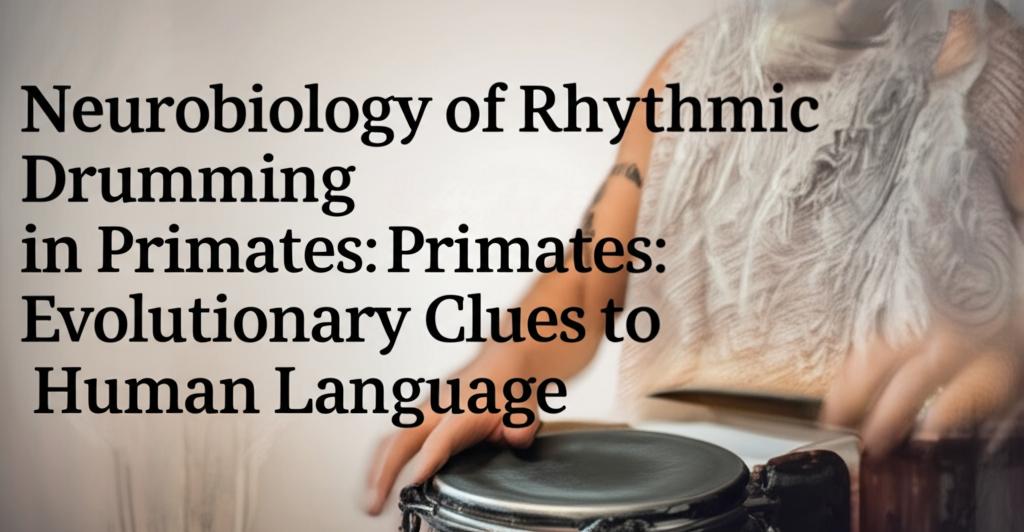Rhythmic drumming in primates, particularly our closest relatives, chimpanzees, offers a fascinating window into the neurobiological foundations of human language. Recent studies are revealing that the capacity for rhythm, a key element of music and speech, is not uniquely human but may have ancient roots shared with other primates.
Chimpanzees and Rhythmic Drumming:Groundbreaking research published as recently as May 2025 has demonstrated that wild chimpanzees engage in rhythmic drumming, and these patterns can even differ between subspecies. This work, involving meticulous analysis of drumming behaviours, suggests that the neurological and behavioural underpinnings of rhythm might trace back to a common ancestor of humans and chimpanzees. This challenges the long-held notion that non-human primate communication is largely arrhythmic. Instead, it appears chimpanzees possess an innate capacity for rhythm-based signalling.
Researchers have observed chimpanzees hitting tree trunks and roots with deliberate rhythm and timing, often while traveling and hooting. These drumming bouts are not random; they exhibit structured rhythmicity. Interestingly, individual chimpanzees can have their own distinct drumming styles, and there are even regional variations in drumming patterns between different chimpanzee communities and subspecies. For instance, West African chimpanzees have been observed to drum with regularly spaced hits at a fast tempo, while East African chimpanzees tend to mix shorter and longer hits in their rhythms.
Evolutionary Clues to Human Language:The presence of rhythmic drumming in chimpanzees provides crucial clues about the evolution of human language and musicality. Since language and music don't fossilize, studying the abilities of our closest living relatives is vital. The findings suggest that the building blocks of rhythm were likely present long before humans evolved into their current form. This rhythmic proclivity could be an ancestral behavioural trait that predates the evolutionary split between humans and chimpanzees, which occurred around 6 million years ago.
The neurobiology behind this is also an active area of investigation. Studies using functional imaging in macaques, another primate species that displays drumming behaviour, have shown that vocal and nonvocal communication sounds (like drumming) are represented by overlapping networks in the brain's temporal lobe. Specifically, areas in the caudal auditory cortex and the amygdala show shared neural representation. This suggests a common origin for primate vocal and nonvocal communication systems and lends support to theories proposing a gestural or rhythmic origin of speech and music.
Furthermore, research into chimpanzee lip-smacks, a behaviour observed during grooming, has revealed a speech-like rhythm. Chimpanzees produce these lip-smacks with open-close mouth cycles averaging around 4-5 Hz (cycles per second), which is similar to the rhythm of human speech. This finding, along with similar observations in orangutans and other monkey species, strongly indicates that human speech rhythm was built upon pre-existing primate signal systems.
Beyond Drumming: Other Rhythmic Behaviours and Language Precursors:The investigation into primate rhythmic abilities extends beyond drumming. Studies have noted that rhesus macaques exhibit lip-smacking behaviour with rhythmic properties similar to human speech (around 3-8 Hz). Some primate species, like marmosets, also engage in turn-taking during vocal communication, demonstrating cooperative coordination – a fundamental prerequisite for discourse.
While non-human primates may not possess language in the same complex way as humans, and their vocal learning abilities might be limited, these findings suggest that key neurobiological and cognitive "ingredients" for language, particularly those related to rhythm and temporal processing, were already present in our primate ancestors.
The Bigger Picture: Multimodal Communication and Future Directions:The field is increasingly moving towards a multimodal approach, recognizing that human language likely didn't evolve from a single modality. Researchers are now studying various signal types (vocal, gestural, rhythmic) in an integrated way.
Ongoing research continues to explore the neural and genetic mechanisms that enable rhythm perception and production in primates. The discovery of mirror neurons in monkeys, in a brain region homologous to Broca's area (critical for human language), further supports the idea that the neurobiological systems for motor coordination were co-opted for language evolution.
In conclusion, the study of rhythmic drumming and other rhythmic behaviours in primates is significantly advancing our understanding of the evolutionary trajectory of human language. It underscores that the capacity for rhythm is a deeply rooted trait, shared with our primate cousins, and that the neurobiological foundations for complex communication, including speech, have ancient origins. Future research will undoubtedly continue to unravel the intricate connections between primate drumming, rhythm cognition, and the uniquely human ability for language.

